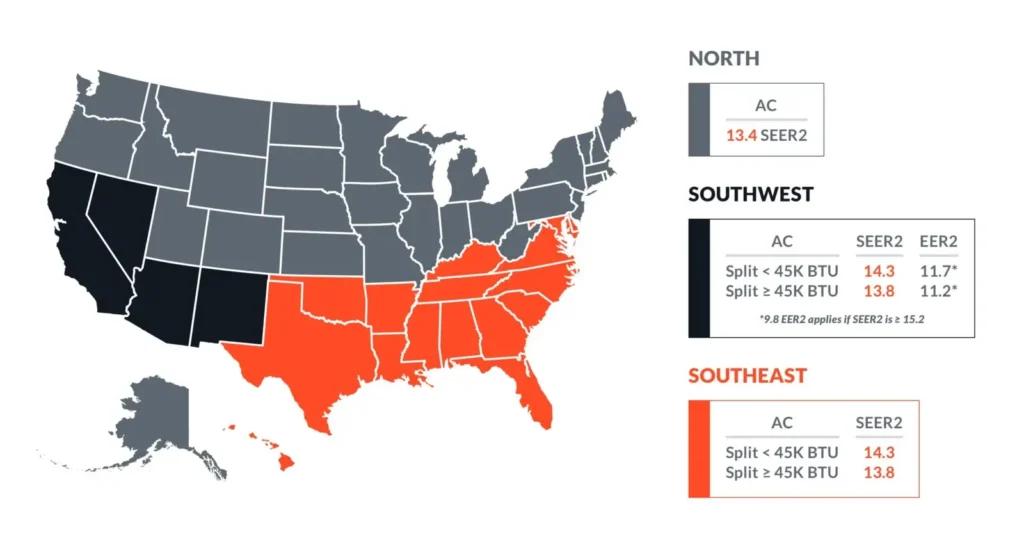AFUE, EER2, HSPF2 & SEER2: What Do They All Mean?
Each of these acronyms describes energy efficiency in HVAC terms. The higher the numbers, the more efficient an HVAC unit is. In this guide, we break it all down for you.

By Anne Fonda
The HVAC industry is chock-full of acronyms. Using shorthand for long phrases can be confusing if you’re not in the know. But it doesn’t have to be. Let’s start at the beginning. HVAC stands for Heating, Ventilation, and Air Conditioning. It’s an all-encompassing term for your heating and cooling system.
If this is your first time researching a new HVAC system, all the energy efficiency acronyms may look like an alphabet soup. Learning what these terms mean can help you choose the best system for your home, budget, and sustainability goals.
Let’s get started.
On January 1, 2023, the U.S. Department of Energy (DOE) implemented new baseline energy efficiency requirements for residential air conditioners and heat pumps. The new standards are different for different areas of the country. Before the modification, several energy efficiency measures included SEER, EER, and HSPF. Under the updated guidelines, the ratings have become SEER2, EER2, and HSPF2.
The goal of the new standards is to lower energy consumption by increasing energy efficiency. A bonus for homeowners: You can realize energy cost savings by buying a more efficient HVAC system.
Our first two energy efficiency metrics refer to your cooling system’s efficiency. SEER2 and EER2 ratings apply to central air conditioners and heat pumps

Understanding SEER2
SEER2 is short for Seasonal Energy Efficiency Rating. An AC unit or heat pump’s cooling efficiency varies based on the temperature outside. The cooling unit is more efficient and uses less electricity on mild days, but is less efficient on hotter days because it has to work harder to keep your home cool.
SEER2 measures the unit’s AVERAGE efficiency over a range of temperatures from 65-104°F. The greater the SEER2 rating, the higher the efficiency of the unit throughout that spectrum. If you plan it right, you can cut your energy usage and save money on your cooling bills if you purchase a more efficient unit.
SEER is the old, lower efficiency rating. SEER2 went into effect in January of 2023. Refer to the map for the new SEER2 requirements. Currently, in the Northern region, every variety of air conditioning units is required to have a SEER2 rating of 13.4 or above. (Equivalent to 14 SEER).
In the Southwest and Southeast, split system air conditioners should possess a SEER2 rating ranging from 13.8 to 14.3, depending on their capacity. (This is comparable to a 14.5-15 SEER).
Split system heat pumps are required to have a SEER2 of 14.3 or above in all areas, while single-packaged air conditioners and heat pumps in all regions should have a SEER2 of at least 13.4.
A unit's efficiency increases with a higher SEER2 rating. A good SEER2 rating for your new heat pump or AC unit will be based on your climate region, the size and layout of your home, and other factors. The best way to determine the best SEER2 rating for your cooling system is to consult with an experienced HVAC professional.
EER2 stands for Energy Efficiency Ratio. Unlike SEER2, which is an average energy efficiency over a range of temperatures, EER2 measures the energy efficiency of an air conditioner or heat pump when the temperature outside is 95°F.
If you live where it’s very hot, such as the desert Southwest, the EER2 rating can be more important than SEER2 because your AC or heat pump will spend a disproportionate amount of time running in extreme heat. Ask your HVAC dealer about EER2 ratings for your area.
In the map, you saw that required efficiency ratings varied by the number of BTUs a unit has. BTU is an abbreviation for British Thermal Unit. It is a unit of measurement that quantifies the heating or cooling capacity of a system.
A larger BTU output means the system will provide more cooling or more heating for a larger space. Installing a system that is sized correctly and has the right capacity to heat and cool your home is important for your comfort and your energy bills.
A system that’s too small may have trouble cooling and dehumidifying your home in the summer or keeping your whole home warm in the winter. It may run for a long time as it struggles to reach the set temperature. In contrast, a system that is too big may be too powerful and may cause leaky ducts or may cool your home too quickly without removing the excess humidity.
Either way, an improperly sized system can decrease your comfort while increasing your energy bills.
Whether you heat your home with a gas furnace or a heat pump, when it’s time for HVAC replacement, it’s important to understand the heating efficiency ratings of the equipment you’re considering. For optimal efficiency and to qualify for tax credits and rebates, you’ll likely need to replace your cooling unit at the same time.
Work with your HVAC professional to choose a matched system that will offer maximum energy efficiency and year-round comfort. All American Standard HVAC equipment is independently rated by the Air Conditioning, Heating, and Refrigeration Institute (AHRI) and receives AHRI certification after testing. This helps ensure our equipment meets or exceeds efficiency standards.
HSPF2 is short for Heating Seasonal Performance Factor. It measures how efficient your heat pump is at heating your home in the fall and winter months.
HSPF is the pre-2023 rating, and HSPF2 is the new version for how efficient a heat pump is in heating mode. The DOE requires that split-system heat pumps possess a minimum HSPF2 rating of 7.5, while packaged heat pumps must achieve at least an HSPF2 of 6.7. Similar to SEER2 ratings, a higher HSPF2 rating indicates a more efficient heat pump.
Talk with an HVAC professional for specific recommendations. In general, you will want a heat pump with a higher HSPF2 rating if you live where you have colder temperatures for several months out of the year. If you live where temperatures drop below freezing for weeks or months at a time, you may want to consider purchasing a cold climate heat pump or pairing the heat pump with a furnace in a hybrid HVAC system.
Opting for an electric heat pump with a high HSPF2 rating can lead to savings on your heating costs. A lot will depend on electricity vs natural gas prices in your area. Your greatest savings would be if you have fuel oil or propane delivered and you upgrade to a heat pump. Opting for a heat pump or dual-fuel heating system can also help reduce your carbon footprint.
AFUE is short for Annual Fuel Utilization Efficiency. It’s a heating efficiency rating that measures how efficiently your furnace converts fuel to heat. Once more, a furnace with a higher AFUE rating is more efficient.
The AFUE rating is expressed as a percentage. The AFUE percentage indicates the proportion of fuel consumed that is used for heating your home. The remaining percentage is what gets lost or wasted. The DOE currently mandates a minimum AFUE of 80% for furnaces.
If you have an aging, inefficient HVAC system that’s costing you more and more in repairs, you’re smart to start learning about all of the energy efficiency terms. A more efficient system can increase your home’s comfort while decreasing your energy bills.
Curious about the potential savings in money and energy you can achieve with a new HVAC system installation? Explore this ENERGY STAR® calculator.
If this is your first time replacing an HVAC system, you’ll want to make sure you hire the right HVAC contractors. Get some tips in our blog Checklist: Finding the Best HVAC Service Near Me.
We hope you’ll include your local American Standard dealer in the mix. For more than 100 years, we’ve made some of the most awarded, well-engineered HVAC equipment, and earned a reputation for doing things right. We have a range of energy-efficient heat pumps, air conditioners, and furnaces to choose from.
Anne Fonda, Content Writer
A Content Writer with Trane Technologies, Anne Fonda researches topics and writes for Trane® and associated residential HVAC brands. She works in collaboration with Trane Technologies subject matter experts, offering easy-to-understand, informative content on complex topics. Her goal is to help consumers make informed decisions on the products and services they need.
She has written for HVAC and other service provider websites for over 16 years. Before transitioning to web content writing, Anne had a 14-year stint as an award-winning journalist. She graduated cum laude from the University of Missouri-Columbia School of Journalism. When she’s not working, Anne enjoys playing word games, reading, gardening, spending time with family, and visiting gardens and museums.
Expert review by Mark Woodruff, Senior Product Manager, Ducted Outdoor



